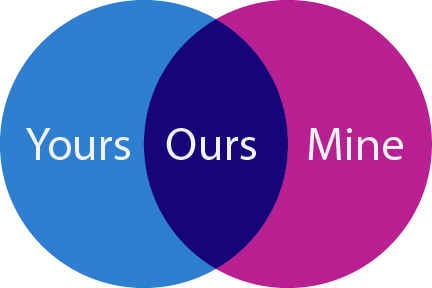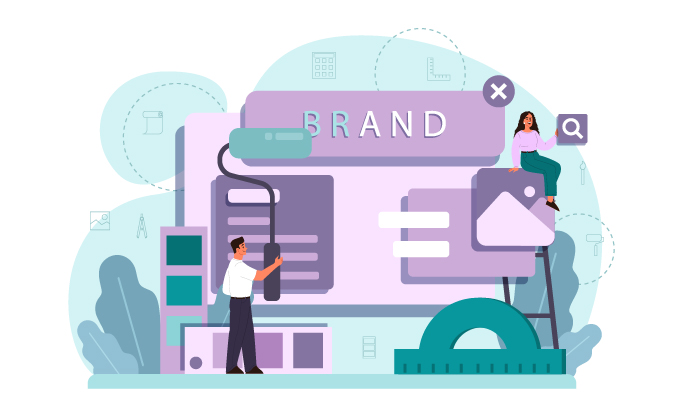
As boomers are retiring and the next generation of leaders is stepping up, we are noticing a LOT of acquisitions and rebrandings in the care management space. Sometimes it’s an employee buying out the founder. Sometimes it’s a company in a different town expanding their reach by buying a practice in a neighboring market. Sometimes it’s a company expanding into home care or adding a new physical therapy or occupational therapy division that allows them to offer a diverse set of services.
Whatever your circumstance, there are many details to work through and many marketing challenges to address. Let’s look at the issues.
Yours? Mine? Ours?
 Will you change the name of the business? Even if the intention is to merge two equals, usually one entity is dominant. They may be better known, or larger. In this regard, even the best-intended “mergers” are often an acquisition. And if your company did purchase the other, you still have to decide whether you will keep your name or come up with a third name that reflects the new you.
Will you change the name of the business? Even if the intention is to merge two equals, usually one entity is dominant. They may be better known, or larger. In this regard, even the best-intended “mergers” are often an acquisition. And if your company did purchase the other, you still have to decide whether you will keep your name or come up with a third name that reflects the new you.
If you change the name, you’ve bitten off a MUCH bigger project. In this blog post, I will only be speaking in depth about the marketing and Internet aspects of a merger or acquisition. But I can touch on a few other aspects you will need to address with a name change:
- Creation of a new business entity (LLC, corporation, nonprofit …) with new tax ID numbers from the state and from the IRS
- New bank accounts
- New merchant accounts (e.g., PayPal, a merchant account for accepting credit cards)
- New contracts with clients, vendors, and staff
- Liability insurance under the new name
- City business license
- County assessor’s account
A daunting prospect, and we haven’t even gotten into the marketing side. Nevertheless, there may be advantages of merging the two entities into something that will be recognizable by clients and referrers of both businesses. Especially if the principal of the acquired business will be staying on for a considerable period of time (e.g., five years), they will likely want to see something of their presence retained.
Owners of an acquired business who are staying around for only a few months to a year or two—e.g., in the case of selling to retire—might have to swallow hard and acknowledge that their ship will be sailing. Tomorrow does NOT belong to them. Giving up their company name is simply part of the trade-off and also the eventual joy (“Not my problem anymore!”).
Let’s talk about the easiest route: Keeping your name
You can still be welcoming and show respect for the “acquired business” while retaining your name for legal purposes.

For instance, you broadcast a fresh start with
- a new logo that incorporates elements of both businesses
- adoption of the acquired business’s tagline under your company name
- revision of your color palette to incorporate elements from both businesses (online and with print materials such as rack cards, business cards, letterhead, office signage)
- redesign of your website, signaling something of a “new you”
- a banner across the top of your website that welcomes clients and referrers of the acquired business
- a “Changes” webpage that describes the merger and hopefully includes a video of the owner of the acquired business positively introducing the new owner (purchaser) and expressing confidence and faith in the new leadership
- posting about the changes and putting welcoming and reassuring text on your social media pages
- holding an open house with really good food, or arranging for individual meet-and-greet sessions (coffee, lunch, Zoom meetings) with key referrers where the previous owner introduces the new owner to attorneys, financial planners, and other important colleagues
- an email sent to the clients of the acquired business and another email to their referrers, reassuring them about what will be the same (e.g., for clients, no change in rates, their contracts stand; for everyone, same high quality). It doesn’t hurt to talk about the new owner’s specialty services or niche (solo aging, family caregiving, home safety evaluations …) so clients feel they may also be gaining something in the process. If you made a video for the website, add a link to it in the email so people can “meet” the new owner
- emails to your existing clients and referrers letting them know about new faces, perhaps new capabilities, or a wider service area. Again, be reassuring about what will stay the same (ideally no rate hike). A link to the Changes video is also worthwhile so those who are interested can learn more
- a 301 redirect on the acquired business’s website that sends viewers to the home page or Changes page on the purchasing business’s website. (You very specifically want a 301 redirect because it flags Google that this is a permanent change and passes along as much of the “Google juice”—ranking power of the page—as is possible.)
Greater depth
I’ve addressed these changes in the context of one company acquiring another. But if you will truly be merging with a brand-new name, then these tasks apply, but you have to do them for both the acquired and purchasing entities and point to the new “third” company.
- Place 301 redirects on every page of the acquired company’s website, forwarding to the corresponding page on the purchasing company’s website. This is less frustrating for clients and referrers of the acquired business because they will get to a page that does essentially what the other page did (e.g., pay your bill online, make a referral, schedule a consultation). And it will bring over the ranking power on Google. But it does require a site audit of both websites and a very particular one-to-one matching of pages. (You may need to add a page that you didn’t have, to ensure that acquired clients can seamlessly conduct business with you, their new care management company.)
- Become the site admin for all the acquired company’s social media accounts so you can announce the change.
- Facebook business page
- LinkedIn Company page
- Google Business Profile
- Instagram, Twitter, and YouTube pages, if they have them
Not all platforms allow for a merger. Facebook and LinkedIn will, but their procedures are quite exacting.
The Google Business Profile will likely have to be taken down, unless the acquired business is in another location from your home location (e.g., you bought a business in a neighboring market that allows you to expand your reach). In that case, you can just change the name of the company in that new location. You may need to do some verification for Google, but the good news is you get to keep the reviews and site authority, presuming they are both good.

Use this change as an opportunity to revamp your processes
This is a bigger undertaking. It’s more of an infrastructure change. But particularly if you are inheriting staff, it’s worth interviewing them to see what they like and dislike about the processes they’ve been using and what they wish they had. Then ask your own team the same questions.
Look on the acquired business’s site for special links to third-party websites (e.g., a scheduling program for consultations, an “apply online” program for home care workers, an hours/payroll program for staff out in the field, charting software). It may be that the acquired company has some processes that would be good for your entire staff to adopt.

Consider Google ads
Those who know me know that as a general rule, I’m not real keen on pay-per-click advertising for care management. It takes a lot of investment to yield a sale (usually only 1 in 1,000 impressions or clicks results in a full contract). But in this case, it’s quite worth it to pay for a sponsored ad that leads to your Changes page when people type in the name of the acquired business. First of all, that’s not going to be an especially competitive keyword phrase, so the price won’t be expensive. Second, it helps clients, referrers, and the general public realize there’s been a merger and to cement your name in association with the other company’s name and brand.
If you decide to take on a new name for the merger, then of course pay for ads for searchers looking for your “old name.” Run these campaigns for at least three to six months.

What is yours from the acquired company?
You may have been very clear about physical assets (computers, desks, etc.), but what about digital assets? They have value. You need to be sure their ownership has been delineated in your sales agreement.
- Forms, documents, graphics, videos. These are typically included. You will want copies given to you to store on your own server.
- The “old” website. Get a download of it just in case there’s a need to backtrack and see what was said.
- Blogs and newsletters. Do these belong to the owner, or are they syndicated content that has been licensed only to the acquired company or to their service area? You may be able to assume the license provided there isn’t another client in your territory that has already licensed the publication.
Congratulations!
Purchasing a business is an exciting adventure.
But there are a lot of details to track.
If you want help with a website refresh
or a new website representing your combined businesses, let’s talk!
We know tech and we know care management.
Email me at tasha@elderpagesonline.com.

